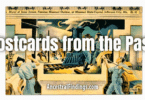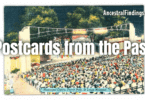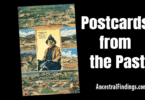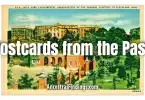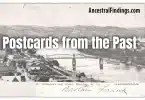I pulled this one from the box the other day—a postcard that’s more than just a snapshot. It’s a whole afternoon, frozen in place. I’ve looked at it a dozen times now, and I keep finding new things. The light on the red brick, the ivy climbing the walls, the quiet blur of someone mid-stride. It’s not a staged photo. It feels lived in, like if I stood still long enough, I might hear the hum of a saxophone or catch the smell of espresso drifting out from a corner café.
This is Greenwich Village, New York City. The card’s from the 1960s, and it captures something that’s hard to explain unless you’ve felt it yourself—this neighborhood’s rhythm. The front shows a row of artists set up along the sidewalk, their work leaned up against the building as if it naturally belongs there. People wander past with curiosity, maybe looking for something to hang in a tiny walk-up apartment or just pausing to admire.
And there’s a red station wagon parked at the curb. Maybe the artist who drove it there hauled every one of those paintings in its back seat. Maybe someone was moving in—or out. That’s how the Village was. A place of transitions. A place for the almost-famous, the nearly-there, the deeply passionate.
The back of the card reads:
“One of the most colorful districts in New York, a Bohemian atmosphere pervades this part of the city where artists, writers, sculptors, composers, actors and beatniks make their home. Here will be found off-Broadway shows, nite-clubs, a great variety of restaurants, exciting Espresso shops and friendly people.”
It’s almost poetic. Whoever wrote this had the right idea. You can’t describe the Village without using words like “Bohemian,” and you definitely can’t describe it without talking about the people. The place didn’t create the magic—the people did.
Where Rebellion Met Art
In the early 20th century, Greenwich Village was where outsiders found each other. It wasn’t just a haven for artists—it was a proving ground. Poets performed in basement cafés lit by candlelight. Actors staged plays in converted garages. Sculptors set up studios in old stables. And if you were hungry, there was always a diner or a friend with a half-loaf of bread and a bottle of cheap wine.
This is where Edna St. Vincent Millay scribbled poems in narrow rooms. Where Dylan Thomas drank too much and turned it into verse. Where Allen Ginsberg and the Beats wrestled with the bones of society and built something raw and honest.
The postcard doesn’t show those moments. But somehow, it hints at them. It shows the leftovers of a creative storm that had already passed through and left its signature on the bricks and sidewalks.
The Village on Canvas
I love the idea that some of the paintings in this photo might still be hanging on someone’s wall. Maybe above a fireplace, maybe tucked into a hallway—quietly existing, long after the sidewalk sale ended. The artists who brought them probably hoped for more. Maybe they dreamed of galleries, or Paris, or just enough sales to cover rent for one more month.
That’s something I admire—people who create because they can’t help it. The Village was full of them. Still is, if you look carefully.
A Bohemian Time Capsule
I’ve never lived in New York. Never spent a week in the Village. But this postcard gives me a little piece of it. And when I hold it, I imagine walking past that ivy-covered building. Maybe I stop to look at the art. Maybe I buy a small canvas with a painted skyline. Maybe I sit on a bench, and the city moves around me in a blur of purpose and poetry.
Places like this matter. They remind us of who we’ve been, and who we might still become.
Send Me Yours
I’ve been collecting postcards for years now—thousands of them. Some were handed to me. Some arrived in the mail from friends and strangers who knew I’d appreciate the view. If you’ve got a favorite, I’d love to see it.
Head over to AncestralFindings.com, click on the contact link, and send me a message. I’ll give you my mailing address. And who knows? Maybe your postcard will end up in one of these episodes.
I’ve got plenty more to share in this Postcards from the Past series. Each one is a little window into a place I may never go, but still get to visit—one image at a time.
Until next time,
Will


